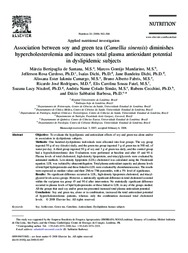Association between soy and green tea (Camellia sinensis) diminishes hypercholesterolemia and increases total plasma antioxidant potential in dyslipidemic subjects.
Association between soy and green tea (Camellia sinensis) diminishes hypercholesterolemia and increases total plasma antioxidant potential in dyslipidemic subjects.
Author(s): SANTANA, M. B. de; MANDARINO, J. M. G.; CARDOSO, J. R.; DICHI, I.; DICHI, J. B.; CAMARGO, A. E. I.; FABRIS, B. A.; RODRIGUES, R. J.; FATEL, E. C. S.; NIXDORF, S. L.; SIMÃO, A. N. C.; CECCHINI, R.; BARBOSA, D. S.
Summary: One hundred dyslipidemic individuals were allocated into four groups. The soy group ingested 50 g of soy (kinako) daily, and the green tea group ingested 3 g of green tea in 500 mL of water per day. A third group ingested 50 g of soy and 3 g of green tea daily, and the control group had a hypocholesterolemic diet. Evaluations were performed at baseline and after 45 and 90 d. Plasma levels of total cholesterol, high-density lipoprotein, and triacylglycerols were evaluated by automated methods. Low-density lipoprotein (LDL) cholesterol was calculated using the Friedewald equation. LDL was isolated by ultracentrifugation. Total plasma antioxidant capacity and plasma levels of total lipid hydroperoxides and those linked to LDL were evaluated by chemiluminescence. The results were expressed as median values and their 25th to 75th percentiles, with a 5% level of significance.
Publication year: 2008
Types of publication: Journal article
Unit: Embrapa Soybean
Keywords: Hipercolesterolemia
Observation
Some of Embrapa's publications are published as ePub files. To read them, use or download one of the following free software options to your computer or mobile device. Android: Google Play Books; IOS: iBooks; Windows and Linux: Calibre.
Access other publications
Access the Agricultural Research Database (BDPA) to consult Embrapa's full library collection and records.
Visit Embrapa Bookstore to purchase books and other publications sold by Embrapa.

